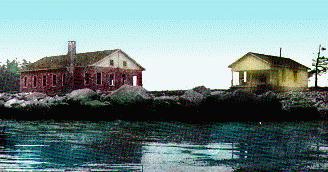 |
 |
 |
Location
The Tusket Islands are located South of Yarmouth, N.S. along the coast from Pinkney's Point to Wedgeport. Many of the islands involved in the Tusket Islands group have a storied past. Among them are Allen Island, Pease Island, Spectacle Island, Ellenwood Island, Murder Island, Holmes Island, Haymaker Island, Turpentine Island, Owls Head Island, Eagle Island, Marks Island, Candlebox Island, Tarpaulin Island, Dog and Calf Islands, Big Island, Green Island and others. Tusket Island itself has the highest
elevation
of 100 feet and Bald Tusket is 50 feet high. Only a few houses were
ever
built on the islands.
Date: 7/26/2011 Name: Barbara Cottreau Paon Location: New Brunswick Comments: I stumbled on this site while looking up some family history. I noted a few mistakes on the page about the Tusket Islands. The Island that had a family of nine living on their own was indeed Candle Box Island, not Tusket Island. That family was my Grandparents, Norman and Clara Cottreau with my dad and his siblings, at least a dog or two and perhapes cats! And, by times, a hired girl! Who could possibly be lonely on that 1 acre island? LOL Grampy was the light keeper there for 26 years. Thank you for the corrections...webmasterd Thank you |

Economic Asset Boats can pass through the Schooner and the Ellenwood Islands in a Northwest or Southeast direction. At one time they had twice-weekly freights coming through and had mail deliveries. They had their own stores and they were an economic asset to Southwestern Nova Scotia. There were many lighthouses and a good-sized fishery; but through the years fishing diminished and people started to leave. If you walk on the beaches today you'll find evidence of the fishing industry in the debris and rotting wood lying along the shores. In 1936 there was an attempt to build an Acadia Tuna Club on Owls Head, one of the Tusket Islands. There were in the 1930's two houses, one of stone and a smaller one of wood. They were used to accommodate sports tuna fishermen from the U.S. The smaller one was the guest ouse. The big stone building was the main lodge which had a fireplace, dining room and kitchen. Boats would come there from Little River Harbour on the mainland. World War II put an end to the Club. Haymaker Island had a department store that sold clothing, shoes, hats, and lobster gear. This building still exists. There were also lobster canning
factories on Deep
Cove, Ellenwood, Calf, Murder, Dog and John's Islands. These
factories
closed around 50 years ago when small lobster fishing was banned.
|
| Lighthouses
Pease Island has a lighthouse 42 feet high. At Candlebox Island the first lighthouse was built in1893 , and the fog signal was added in 1896. Locals say it's a nice trip to Pease, but not in winter.The Candlebox light station was officially closed June of 1986, after being in operation since1893. In 1982 there was still a lighthouse on Green Island but the houses were destroyed. You'll also see on Green Island a narrow cove where the fishermen landed their boats.. There was also a house used by the RCMP for demolition practice. The house no longer exists. When Trouble Struck Boats had problems getting off the
Islands on
stormy days. When it rained, water would get into the foghorn
equipment
and it wouldn't work.
Other problems would arise for those needing to work for only one day who were then unable to leave for two or three days. Imagine living on an island when you can't leave, you have no power, no telephone and no connections to the outside world. During harsh weather, the tidal streams would increase to 2-4 knots. In 1966 off Ellenwood and Schooner passages, Ellenwood went up to 2 knots and Schooner passage went to 4 knots. Background History Murder Island, an intriguing name, was said to have been the scene of a fierce battle, either between Indians and whites or between two tribes of Indians, the Iroquois and the Mi'kmaq. Normally the houses in the Tusket Islands would have a kitchen-living room, pantry and a bedroom downstairs. The upstairs only had one room. On Tusket Island there was at one time a family of nine living on their own. They lived in a house beside the lighthouse. Lois Nickerson relates that they found themselves relying on one another's company to play since there was no one else around. She would tell how close their family was and, looking at families today, she said she felt discouraged at the difference. However, around Southern Nova Scotia, you wll find that families still are bonded and that a friendly atmosphere still prevails Links Lots of good lobster chat: http://www.1stforlobster.com. .
|
Research by Maxine Dion
update-09/09/2001 & 2011